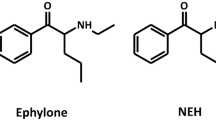Summary
The metabolism of cephaeline and emetine, which are the primary active components of ipecac syrup, were investigated in rats. Cephaeline-6′-O-glucuronide was found to be a biliary metabolite of cephaeline. Cephaeline (6′-O-demethylemetine) and 9-O-demethylemetine were observed to be enzyme-hydrolyzed biliary metabolites of emetine. Cephaeline was conjugated to glucuronide, while emetine was demethylated to cephaeline and 9-O-demethylemetine, and may be conjugated to glucuronides afterwards. Urine, feces and bile were collected from rats within 48 hours following the administration of ipecac syrup containing tritium (3H)-labeled cephaeline or emetine. Metabolites were separated and quantified by thin layer chromatography (TLC) or high-performance liquid chromatography (HPLC). Biliary and urinary excretion rates of3H-cephaeline were 57.5% and 16.5% of the dose, respectively. Cephaeline-6′-O-glucuronide was comprised 79.5% of biliary radioactivity and 84.3% of urinary radioactivity. Unchanged cephaeline was detected in 42.4% of the dose in feces. Biliary excretion rate of3H-emetine was 6.9% of the dose. Emetine, cephaeline and 9-O-demethylemetine comprised 5.8%, 43.2% and 13.6% in hydrolyzed bile, respectively. There were no emetine-derived metabolites in urine or feces. The occurrence of unchanged emetine was 6.8% and 19.7% of the dose in urine and feces, respectively.
Similar content being viewed by others
Reference
Manno B.R., Manno J. E. (1977): Toxicology of Ipecac: a review, Clin. Toxicol. 10:221–242.
Asano T., Ishihara K., Yanagisawa T., Kimura M., Kamei H., Yoshida T., Kuroiwa Y., Fujii Y., Yamashita M., Kuramochi T., Tomisawa H., Tateishi M. (2002): Absorption, distribution and excretion of 3H-labeled cephaeline and emetine spiked ipecac syrup in rats. Eur. J. Drug Metab. Pharmacokinet 27:17–28.
Sobiczewska M., Borkowski B. (1970): Determination of cephaeline in Radix Ipecacuanhae. Acta. Pol. Pharm. 27:469–472.
Fujii T., Ohba M. (1985): Quinolizidines. XI. Structure determination of the Alangium Alkaloid desmethylpsychotrine through synthetic incorporation of ethyl cincholoiponate into (+)-9-demethylpsychotrine. Chem. Pharm. Bull. 33:583–590.
Fujii T., Ohba M., Suzuki, H. (1985): Quinolizidines. XII. Synthetic incorporation of ethyl cincholoiponate into a tricyclic intermediate adaptable to chiral syntheses of the 10-hydroxy-9-methoxybenzo[a]quinolizidine-Type Alangium Alkaloids. Chem. Pharm. Bull. 33:1023–1028.
Fujii T., Ohba M. (1985): Quinolizidines. XVI. Chiral syntheses of 9-demethylcephaeline and 10-demethylcephaeline. Chem. Pharm. Bull. 33:5264–5269.
Budzikiewicz H., Pakrashi S.C., Vorbr ggen H. (1964): Die isolierung von emetin, cephaelin und psychotrin aus Alagium Lamarckkii und die identifizierung von Almarckine mit N-methylcephaelin. Tetrahedron 20:399–408.
Peeples A, Dalvi R. R. (1982): Toxic alkaloids and their interaction with microsomal cytochrome P-450 in vitro. J. Appl. Toxicol. 2:300–302.
Halbing L., Gutmann L., Goebel H., Brick J. F., Schochet, S. (1988): Ultrastructural pathology in emetine-induced myopathy. Acta Neuropathol. 75:577–582.
Adler A. G., Walinsky P., Krall R. A., Cho S. Y. (1980): Death resulting from ipecac syrup poisoning. JAMA 243:1927–1928.
Dresser L. P., Massey E., Johnson E. E., Bossen E. (1993): Ipecac myopathy and cardiomyopathy. J. Neurol. Neurosurg. Psychiatry. 56: 560–562.
Sugie H., Russin R., Verity M. A. (1984): Emetine myopathy: two case reports with pathobiochemical analysis. Muscle Nerve 7:54–59.
Pan S. J., Combs A. B. (1995): Effects of pharmacological interventions on emetine cardiotoxicity in isolated perfused rat hearts. Toxicology. 97:93–104.
Wenzel D. G., Cosma G. N. (1984): A model system for measuring comparative toxicities of cardiotoxic drugs with cultured rat heart myocytes, edothelial cells and fibroblasts. I. emetine, chloroquine and metronidazole. Toxicology. 33:103–115.
Epstein D. (1932): The action of emetine and cephaeline on the circulation, uterus and intestine. Q. J. Pharm. Pharmacol. 5:21–32.
Roming R. A. (1984): Effects of pharmacological interventions on emetine cardiotoxicity in isolated perfused rat hearts. Am. J. Psychiatry. 141:1639.
Author information
Authors and Affiliations
Rights and permissions
About this article
Cite this article
Asano, T., Watanabe, J., Sadakane, C. et al. Biotransformation of the ipecac alkaloids cephaeline and emetine from ipecac syrup in rats. Eur. J. Drug Metab. Pharmacokinet. 27, 29–35 (2002). https://doi.org/10.1007/BF03190402
Received:
Issue Date:
DOI: https://doi.org/10.1007/BF03190402




